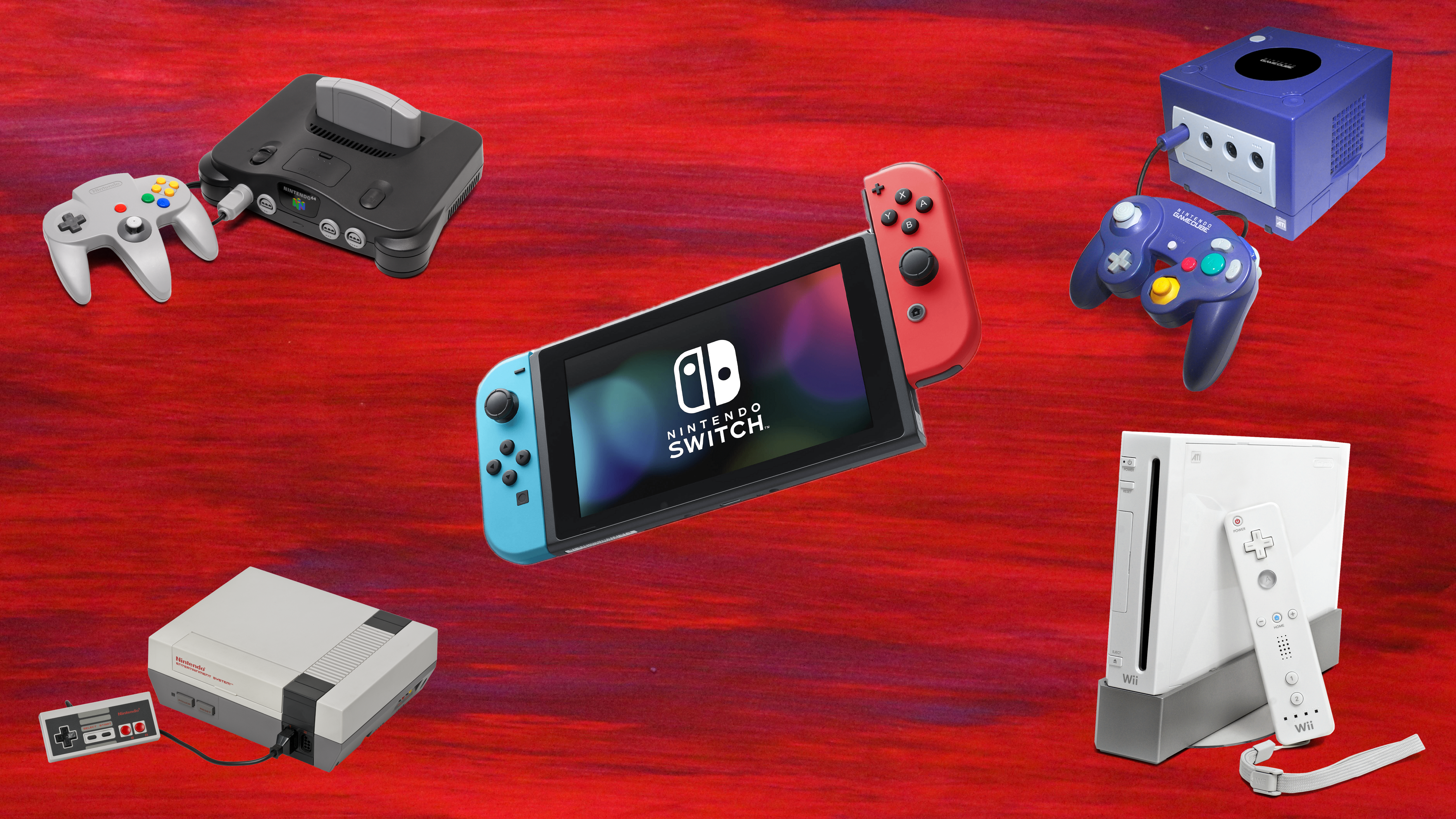Nintendo is the most recognizable name in history when it comes to video games. From the beginning, Nintendo has been at the forefront of creativity and innovation in the home console space. Nintendo is known for its vast library of treasured IPs, with many offering the same charm dozens of years later. With so many upcoming titles, the company is showing no signs of slowing down. Now that Nintendo has officially announced the Switch 2, you may be wanting to take a look back at the gaming giant’s history in the console space.
Below, we’ve rounded up every single console Nintendo has ever released. Journey through the ages and discover how Nintendo has continued to push the gaming medium forward!
Looking to save on a new Nintendo Switch or new titles for your system? Be sure to check out the best Nintendo deals available today.
How Many Nintendo Consoles Have There Been?
In total, 32 Nintendo consoles have been released throughout Nintendo’s history. The Switch 2 will be the 33rd. We’ve included revision models for both home and handheld consoles, which include brandings like XL and Mini.
Every Nintendo Console in Order of Release
Color TV-Game – June 1, 1977
The Color TV-Game line of systems was Nintendo’s first foray into gaming hardware and one that you might not necessarily be aware of. These devices were a joint venture by Nintendo and Mitsubishi Electronics, with the latter involved as Nintendo was inexperienced at developing hardware. These systems were a major success at the time and ultimately led Nintendo to divert its focus to developing more gaming hardware. Almost 50 years later, the Color TV-Game’s legacy is still felt, with Nintendo invested more than ever in gaming.
Game & Watch – April 28, 1980
Nintendo’s first foray into the handheld market was with its Game & Watch devices, each loaded with a different game. While you might not think much of it, the Game & Watch series sold more than 40 million units worldwide. These devices brought many gaming revelations that are still utilized today, such as the D-Pad in the Donkey Kong Game & Watch. These consoles made a comeback somewhat recently when Nintendo released limited edition models in 2020 and 2021 to celebrate the anniversaries of Mario and Zelda.
Nintendo Entertainment System – October 18, 1985
The Nintendo Entertainment System (NES) is the first Nintendo home console to be released in North America. Known as the Family Computer (Famicom) in Japan, this console implemented cartridges to allow users to purchase and play as many games as they’d like on the system. Almost all of the major Nintendo franchises we know and love got their starts here, with series like Super Mario, The Legend of Zelda, and Metroid. Overall, the NES is one of the most important consoles in video game history, as it established a pipeline for generations to come.
Game Boy – July 31, 1989
The first true Nintendo handheld video game console is the Game Boy, which released in North America during the Summer of 1989. Game Boy took a major step forward from the Game & Watch, offering cartridges so you could play as many games as you’d like on the system. For many, the Game Boy’s most well-known game is Tetris, which was bundled in with the system in every region with the exception of Japan.
Super Nintendo Entertainment System – August 23, 1991
The Super Nintendo Entertainment System (SNES) brought 16-bit graphics to a Nintendo platform for the first time. This console was when Nintendo began crafting major evolutions for their biggest series, with games like Super Mario World, Donkey Kong Country, and more. Despite launching toward the latter part of this console generation, the SNES still managed to be the best-selling console of this time period with its profound software lineup and generational appeal.
Virtual Boy – August 14, 1995
The Virtual Boy is quite possibly Nintendo’s weirdest console. This portable device was the first-ever video game console that could properly display 3D visuals. Merely 22 games were ever released for the system, with Mario’s Tennis, 3D Tetris, and Virtual Boy Wario Land among the most popular. Virtual Boy only lasted on the market for one year, with just under 800,000 units sold in its lifetime.
Game Boy Pocket – September 3, 1996
The Game Boy Pocket is a smaller version of the Game Boy, featuring a definitive black-and-white screen instead of the Game Boy’s green-tinted display. One of the biggest improvements of this release was the new hardware inside that improved the response time of the display on screen. However, with the smaller design, the Game Boy Pocket had a shorter battery life than the Game Boy.
Nintendo 64 – September 29, 1996
Nintendo 64 brought 3D graphics to a Nintendo home console for the very first time. This revolutionary device brought two of the most influential titles ever: Super Mario 64 and The Legend of Zelda: Ocarina of Time. The N64 completely refreshed what the NES and SNES offered with a bold new controller that featured an analog stick for the first time. N64 is one of the few consoles where Nintendo sold many iconic special editions, with multiple translucent variants available.
Game Boy Light – April 14, 1998
Game Boy Light is a console you might not be too familiar with, and a large part of that is likely due to it being exclusive to Japan. This Game Boy revision was bigger than the Game Boy Pocket, but added a new backlight so players could play in low-light areas. Ultimately, this change allowed for the Game Boy Light to feature longer battery life than the Game Boy Pocket, around 20 hours in total.
Game Boy Color – November 18, 1998
Game Boy Color finally brought color to a Nintendo handheld. The device was backwards-compatible with all Game Boy games, so it was an easy upgrade for many. Some Game Boy games had support for color already, so titles like Tetris could be experienced anew with bright and beatuiful colors. With the new hardware inside, hundreds of new games were also released exclusively for the system.
Game Boy Advance – June 11, 2001
Game Boy Advance (GBA) was the first massive technological leap forward in the Game Boy brand for Nintendo. In a major shakeup to the previous Game Boy models, GBA flipped the device orientation to a horizontal, rectangular shape versus the portrait-designed Game Boy. 16-bit graphics were now available portably — a major upgrade from the Game Boy’s 8-bit graphics support. Of course, Game Boy and Game Boy Color games were also supported via backwards compatibility. This opened the number of games available on GBA into the thousands.
Pokémon mini – November 16, 2001
Pokémon mini released in 2001 with a major focus on Pokémon games (as the name implies). This device is so incredibly small that you can fit multiple in your pocket. Only 10 games were ever released for Pokémon mini, with just four in North America. Pokémon mini featured a built-in clock function, an infrared port for communication, and built-in rumble.
Nintendo GameCube – November 18, 2001
Nintendo GameCube built upon the success of the Nintendo 64 and followed up with sequels to many of the beloved titles found on the system. Super Mario Sunshine, The Legend of Zelda: Wind Waker, and Super Smash Bros. Ultimate are all three titles that shined on the system. GameCube made a major departure from Nintendo’s prior home consoles, as it utilized discs instead of cartridges. Additionally, the controller made major improvements from N64, with built-in rumble, analog/digital triggers, and a staggered design for the sticks. The legacy of the GameCube still lives on today, with many of the franchises that debuted on the title more popular than ever. (Looking at you, Animal Crossing.)
Panasonic Q – December 14, 2001
Panasonic Q is a collaborative console between Panasonic and Nintendo. This device combined a traditional GameCube with a DVD player, allowing for users to play GameCube titles, watch DVDs, and listen to CDs. Its design is striking, with a stainless steel exterior and a front LCD panel. Due to the steep price and low sales, the console only lasted two years on the market.
Game Boy Advance SP – March 23, 2003
Game Boy Advance SP (GBA SP) was the first revision of the Game Boy Advance. A major change from the previous model was the hinge design, which placed the screen on the top panel and the controls on the bottom panel. Additionally, the GBA SP featured a chargeable battery and a backlit screen (exclusive to later models), which were both major improvements from its predecessor. Nintendo opted to omit a headphone jack on this model but offered an adapter for players to listen to audio through headphones.
Nintendo DS – November 21, 2004
Nintendo DS was the first unit in the DS line, which marked the start of Nintendo’s best-selling console. The DS featured Wi-Fi support for the first time, with a standout clamshell design that expanded upon the Game Boy SP. With two screens, games on Nintendo DS were quite unique, with many developers creating experiences unlike anything on the market previously. The bottom screen was a touchscreen that players could use with the included stylus pen.
Game Boy Micro – September 19, 2005
Game Boy Micro was famously revealed by Reggie Fils-Aimé during E3 2005, with many shocked at the small size of the system. The rectangular design featured a D-pad and two buttons on the front, with Start and Select buttons on the bottom side of the unit. Like previous GBA models, Game Boy Micro was backwards compatible with Game Boy and Game Boy Color games, in addition to playing Game Boy Advance titles. Game Boy Micro featured a backlit screen that allowed for adjustable brightness and even lighting across the screen. The system only sold 2.42 million units across 18 months until its production ended.
Nintendo DS Lite – June 11, 2006
Nintendo DS Lite was the first revision of the Nintendo DS. This model released just under a year and a half after the initial launch of the Nintendo DS, and it brought a few changes to the fold. First, the DS Lite is slimmer and lighter than its predecessor. The screens are also both noticeably brighter than the standard DS, which made games easier to see regardless of lighting conditions. Lastly, the battery life was much improved on Nintendo DS Lite to allow for more playtime without the need for a charge.
Nintendo Wii – November 19, 2006
Nintendo Wii marked a huge resurgence for Nintendo’s home console business, with a unique focus on motion controls that sold many on the system. The unique Wii Remote relied heavily on motion to control the system, utilizing both infrared and digital technology to input motion from all directions. Nintendo released all sorts of accessories for the system, from the Nunchuk to the Wii MotionPlus. Wii was backwards compatible with both GameCube titles and controllers, since the Wii utilized optical discs once again. One of the defining software offerings of Wii was Virtual Console, which allowed players to purchase NES, SNES, and N64 titles for digital download.
Nintendo DSi – November 1, 2008
Nintendo DSi made a few changes to the Nintendo DS, acting as the second major revision of the model. It added two cameras, one on the hinge inside and one on the outside panel, which were utilized in games and in certain software. An SD card slot was also added to provide additional storage for downloaded games. Unfortunately, the Nintendo DSi also removed the Game Boy Advance slot that was present on the Nintendo DS and Nintendo DS Lite.
Nintendo DSi XL – November 21, 2009
Nintendo DSi XL was a larger model of the DSi that launched a year after the main model. This device featured larger, wide-view screens that both sat at 4.2 inches. Two speakers were added to the top panel to provide better, clearer sound for players, and a bigger battery for longer playtime. With the larger screens, Nintendo DS games were brighter and easier to experience than ever.
Nintendo 3DS – March 27, 2011
Nintendo 3DS was the successor to the Nintendo DS line, offering a wide variety of new features, games, and hardware capabilities. The key feature of 3DS was the 3D capabilities, which were powered by stereoscopy so no eyewear was required. Interestingly enough, this is the same technology that was used to power the Virtual Boy, which only lasted on the market for one year in 1995. 3DS was a massive upgrade from Nintendo DS, with many impressive titles like The Legend of Zelda: A Link Between Worlds, Fire Emblem: Awakening, and Super Mario 3D Land.
Nintendo 3DS XL – August 19, 2012
Nintendo 3DS XL (known as Nintendo 3DS LL in Japan) featured a screen that was 90% larger than the original 3DS. This console retained every feature of the Nintendo 3DS and simply offered a larger screen. Many games were much easier to view with this model, especially with the bottom screen.
Nintendo Wii U – November 18, 2012
The Nintendo Wii U was the successor to Nintendo Wii, featuring an all-new GamePad controller. This controller featured a screen and could be used to play titles off of the TV. All previous Nintendo Wii games, accessories, and controllers were compatible with the system. Wii U was Nintendo’s first-ever console to support HD, which was a major step up from the 480p capabilities of the Wii. There were some incredible titles released for the system, including Xenoblade Chronicles X, Super Mario 3D World, Splatoon, and Bayonetta 2 to name a few. Ultimately, a combination of poor marketing and confusion led to poor sales of the Wii U, which left Nintendo in a crucial state prior to the launch of Nintendo Switch.
Nintendo Wii Mini – December 7, 2012
Wii Mini was a smaller, lighter Wii unit that was released at the very tail end of the Wii’s life cycle. Wii Mini featured a top-facing disc drive, which was a huge departure from the standard Wii. Additionally, it removed support for GameCube, Wi-Fi connectivity, 480p resolution, and SD cards. This console launched in Canada during December 2012, with releases in Europe and the United States in 2013.
Nintendo 2DS – October 12, 2013
Nintendo 2DS offered exactly what it sounds like: fun, 2D content. This device removed the 3D capability present on 3DS models and instead flattened out the console to a square-like shape. All 3DS titles are playable on 2DS, with all features minus 3D intact. The console did lose considerable sound quality, as the speaker onboard was swapped for a mono speaker versus a stereo speaker. However, with the extremely low price point, Nintendo had to cut costs somewhere.
New Nintendo 3DS – October 11, 2014
New Nintendo 3DS made significant upgrades to the standard 3DS, with new controls, features, and platform support. Nintendo added the C-Stick, ZR and ZL buttons, and NFC support for amiibo with this release. While the New Nintendo 3DS launched across Japan, Australia, and Europe in late 2014 to early 2015, North America did not receive this standard version until September 25, 2015.
New Nintendo 3DS XL – February 13, 2015
Released before New Nintendo 3DS in North America, New Nintendo 3DS XL was a larger version of the revised 3DS model. Although the standard model did feature bigger screens than the standard 3DS, the 3DS XL had even bigger displays, which allowed for more immersive games. The New 3DS XL made a major change from the smaller model as it removed the ability to change face plates. Many felt this limited customization, though Nintendo did offer mutliple special editions for players to purchase.
Nintendo Switch – March 3, 2017
Nintendo Switch fully realized the vision of the Wii U and completely propelled Nintendo to the top of the industry once again. The Switch operates as both a home and portable console, with the ability to play games wherever you go. The same grand experiences you were used to on consoles can now be played in a park, on a plane, or in your bed. With arguably the best first-party library of any Nintendo console, Switch has seen some of the greatest games of all time be released on it. There have also been quite a few special edition Nintendo Switch consoles that have been released throughout the years.
New Nintendo 2DS XL – July 28, 2017
New Nintendo 2DS XL was a major update to the 2DS. Additions for this model included an analog stick, shoulder buttons, amiibo support, and more. 2DS XL also moved back to the signature clamshell-hinge design, which was a departure from the flat panel used for 2DS. This console was also able to play New 3DS titles, which included games like Xenoblade Chronicles 3D and Fire Emblem Warriors.
Nintendo Switch Lite – September 20, 2019
Nintendo Switch Lite shrunk down the body of the Nintendo Switch, utilizing a 5.5 inch LCD screen. The major change with this model was the removal of Joy-Cons, as the controllers became built-in on the sides of the console. As a result of these changes, the Nintendo Switch Lite is only playable in handheld mode and cannot be docked to a TV. This allowed Nintendo to cut costs and charge $100 less for the Lite model.
Nintendo Switch OLED model – October 8, 2021
Nintendo Switch OLED debuted alongside Metroid Dread in October 2021. This premium Switch increased the size of the screen to 7 inches while also adding a new premium OLED panel. In addition to these features, the speakers and kickstand were also reworked for this device. The OLED model released alongside a new dock, featuring rounded corners and a built-in LAN port.
Upcoming Nintendo Consoles
After what felt like a lifetime of leaks and rumors, Nintendo has officially announced the Switch 2. The reveal trailer shows off a new way to attach Joy-Cons (no more sliding), a bigger screen, and a second USB-C port. It’s also looking like you can use your Joy-Con as a mouse, and it’ll be interesting to see whether that mechanic is incorporated into any new first-party games or the countless games rumored to be ported onto the console. Speaking of games, the trailer showcases what almost certainly seems to be a new Mario Kart with 24 spots for players on the track. It also confirms the console will be “mostly” backwards compatible while clarifying it will continue to support both physical and digital games.
Analysts (and some leaks) have estimated the new Nintendo console will be around $400. We’ve compiled everything we know about the Switch 2 based on the trailer, but more information, including, one can imagine, an actual release date, will arrive through a Nintendo Direct scheduled for April 2.
Noah Hunter is a freelance writer and reviewer with a passion for games and technology. He co-founded Final Weapon, an outlet focused on nonsense-free Japanese gaming (in 2019) and has contributed to various publishers writing about the medium.











































